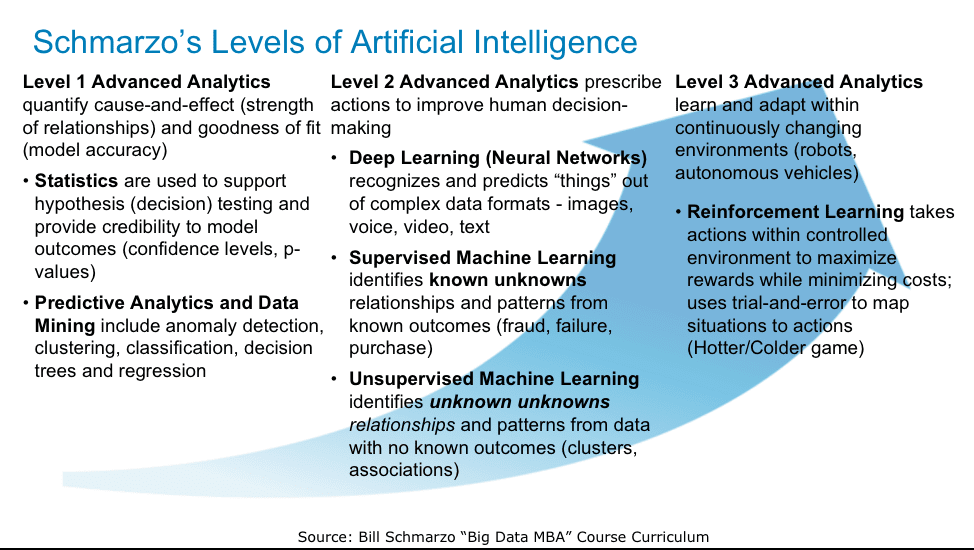Many predict, and warn, that the Artificial Intelligence (AI) Revolution will change the world – and possibly the very essence of mankind. But society-changing revolutions are not new. History is full of such revolutions. What can we learn from those previous revolutions that might provide an indication as to how this AI revolution might play out?
We will examine two other revolutions – the Industrial Revolution and the Information Revolution – for valuable hints as to what we might expect, and how we can better position ourselves to exploit the value offered from these revolutions. And the homework assignmentthat I’m giving all readers is this:
What is the Artificial Intelligence equivalent of the ¼” bolt?
The Industrial Revolution
TheIndustrial Revolutionwas the transition to new manufacturing processes and operational models in the period from 1760 to between 1820 and 1840. The Industrial Revolution was driven by several factors including:
- Interchangeable Parts.These are parts or components that are identical. They are made to standard specifications that ensure that they are identical so that they will fit into any assembly regardless of the manufacturer of the part or component (e.g., ¼” bolt). One such part can freely replace another part, without any custom fitting.
- Factories were built around configurable production lines that enabled the mass-production of goods. Production Lineswere an arrangement in a factory in which an item being manufactured is passed through an optimized set linear sequence of mechanical or manual operations.
- Specialization of Labor.Workers no longer had to be artisans of their craft. The production of goods was broken down into a series of steps that allowed any worker with minimal training to execute. Consequently, workers produce substantially more per unit of effort, enabling businesses to offer higher quality products at lower prices.
- Availability of Steam. Steam wasa readily-available and mobile source of heating, power generation and goods transportation. Factories no longer had to be situated next to streams and rivers for power generation. And steam locomotives could transport raw materials and goods to every part of the country.
But maybe the biggest driver of the Industrial Revolution was the transition from hand-crafted to mass-manufactured goods, a point that is seemingly consistent across all technology-induced revolutions.
The Industrial Revolution brought about many society and personal benefits including:
- Greater Affordability, Accessibility and Quality of Goods. Factories produced items faster and cheaper than could be made by hand. As the supply of various items rose, their cost to the consumer declined. Shoes, clothing, household goods, tools, and other items that enhance people’s quality of life became more common and less expensive.
- Rapid Evolution of Labor-Saving Inventions.The mass production led to the development of new types of tools and vehicles to carry goods and people from one place to another. The growth of road and rail transportation and the invention of the telegraph meant that advances in manufacturing, agricultural harvesting, energy production, and medical techniques could be shared more quickly.
- Rapid Evolution of Medicine. Industrialization allowed medical instruments (e.g., scalpels, microscope lenses, test tubes) to be produced more quickly and less expensively so that basic medical and health care were available to the masses.
- Enhanced Wealth and Quality of Life. Mass production lowered the costs of tools, clothes, and other household items for the common people, which allowed them to save money for other things and build personal wealth.
- Rise of Specialist Professions. To increase the factories’ overall efficiency and to take advantage of new opportunities in the market, factory workers were trained to perform specialized tasks resulting in higher salaries and benefits.
The Information Revolution
TheInformation Revolutionwas marked by the wide-spread commercialization and rapid standardization of computing capabilities (anyone remember the IBM PC Jr?) to automate many everyday tasks and processes with a resulting proliferation of information (data). The Information Revolution was driven by some important technology innovations including:
- Intel x86 CPU Architecture Standardization.The Intel x86 CPU architecture not only standardized the underlying technology architecture but started the free fall in computing and storage costs.
- Growth of Online Transactional Processing (OLTP) Applications. These OLTP applications (e.g., SAP, Oracle, PeopleSoft, Siebel, SalesForce, Baan) automated and standardized many human-intensive, organizational functions like order entry, accounting, payroll, scheduling, manufacturing planning, and inventory management.
- Industry standardization around Microsoft DOS / Windows.While there are many of us who greatly appreciate the Apple OS user experience, it was Microsoft and their aggressive MS-DOS business model that fueled the growth of personal and professional productivity tools like word processing, spreadsheets, presentation and computer-aided design.
- Rapid Growth of the Internet. The Internet effectively shrunk time and distance, enabling humans and devices to communicate seamlessly with any other humans and devices anywhere in the world. The Internet improved knowledge dissemination, dramatically improved connectivity between companies, suppliers and their customers, and enabled new on-line business models.
Again, maybe the biggest driver of the Industrial Revolution was the transition from hand-crafted (custom) technologies to mass-manufactured (standard) technologies. From microprocessors to operating systems to word processors to HR systems, it was easier, cheaper (sometimes) and faster to buy than build it yourself.
Some of the business benefits from the Information Revolution included:
- Increased Production and Time Savings. Businesses used the information revolution to automate and accelerate common, repeatable tasks. This drove a significant increase in worker productivity, increased quality and consistency of work and yielded significant time and cost savings.
- Improved Communication. With the help of communication technology tools like phones, video conferencing, electronic mail and instant messenger, the movement of information within an organization or between individuals became instantaneous, allowing for greater interconnectivity throughout the internal organization as well as along an organization’s extended ecosystem (from suppliers to partners to customers).
- Improved Data Storage, File Management, And Data Reporting/ Analysis. Databases allowed for the capture of all the transactional data that could be used to report on performance and flag performance problems. Databases enabled aggregation of information and supported the subsequent analysis of the data to uncover patterns that drove better and more informed decision making and financial value.
- Improved Financial Management. Businesses were able to more quickly process and calculate financial information and create financial statements thereby improving financial transparency. Plus, the capture of the financial data facilitated detailed performance and management reporting that accelerated the identification of performance problems.
- Reduced Costs of Operation and Increased Return on Investment (ROI). Factors like cost of operation play a significant role in the development and growth of a business. Companies used the information revolution to reduce operational costs and improve ROI which lead to business and commerce growth.
- Improved Business to Consumer Relationship.Businesses embraced the information revolution to interact with their consumers, creating a strong business to consumer relationship and business growth. Business adopted customer-centric information technologies (e.g., Customer Relationship Management, Sales Force Automation) to remain efficient and improve processes, yielding higher customer loyalty rates as they consistently meet and exceed customer expectations and creating new (cross-sell and up-sell) sales opportunities.
- Improves Business Competitive Advantage. Companies gained competitive advantage through superior market and competitive data. Improved data about markets and competitors had direct impact on all aspects of the business including procurement, inventory, pricing, sales, marketing and services.
The Artificial Intelligence Revolution
The start of the Artificial Intelligence (AI)revolution for many occurred in 1950 when Alan Turing published a paper entitled “Computing Machinery and Intelligence”. AI stumbled through many false starts over the next several decades before finally taking root within leading digital companies like Google, Amazon, Facebook, Netflix and Apple embraced AI as a strategic enabler of business differentiation. AI adoption is now available to any company willing to invest the time and resources into analyzing the growing bacchanalia of data to uncover new sources of customer and market value creation.
But before we jump into the key enablers and benefits of AI, let’s first define what comprises AI, because AI is less a specific product and more of a general category of advanced analytics that includes predictive analytics, data mining, machine learning, deep learning and reinforcement learning. See Figure 1 for my take on the 3 levels of advanced analytics.

Figure 1: Three Levels of Advanced Analytics (AI)
Some of the key enablers of AI include:
- Big Data. The availability of inexpensive data storage options is making it cost-effective to capture and store massive volumes of granular structured and unstructured data (e.g., social media, log files, text, video, IOT) about every individual customer, employee (physician, teacher, mechanic, technician) and device.
- Open Source Data Ecosystems. The sudden availability of natively-parallel open source software (e.g., Hadoop, Spark, Hive, HBase, HAWQ) was the perfect, inexpensive data management platform for these massive volumes of structured and unstructured data being generated from transactional systems, web and social media sites, Internet of Things and video surveillance.
- Inexpensive Yet Powerful Computing. The continued trip down the Moore Curve (where processing power doubles roughly every 18 months) continues to drive down the cost of computing, not to mention the sudden explosion of specialized microprocessors such as GPU and TPU that are ideal for AI (machine learning, deep learning) workloads.
- Rentable Cloud. Public and hybrid could options are allowing organizations of all sizes to scale up to whatever compute and storage that they need, renting only what resources they need for the analytic tasks at hand.
- Open Source AI. Powerful open source Machine Learning and Deep Learning frameworks such as Weka, SparkML, TensorFlow and Caffe are democratizing the availability of AI capabilities.
- Data Science. New tools, techniques, methodologies and competencies are budding around the emerging discipline of data science. But thinking that data science is only a technology discipline is the biggest mistake. Instead, all members of an organizations need to start “Thinking like a data scientist” in order to become more effective at leveraging data and analytics to power your business models.
Technology-induced Revolutions Summary
All of these revolutions share a common foundation; they are all about exploiting the changing the nature of economics; about identifying and capturing new sources of customer and market value creation. And the driving force for capturing the economic benefits from each of the Industrial, Information and Intelligence revolutions was the transition from hand-crafted solutions to pre-packaged, mass manufactured solutions.
The transition to pre-packaged AI solutions will require the development of standardized AI and data components. We won’t be able to appreciate the true revolutionary power of the Intelligence Revolution until we get to those standardized components.
So, what is the Artificial Intelligence equivalent of the ¼” bolt?

